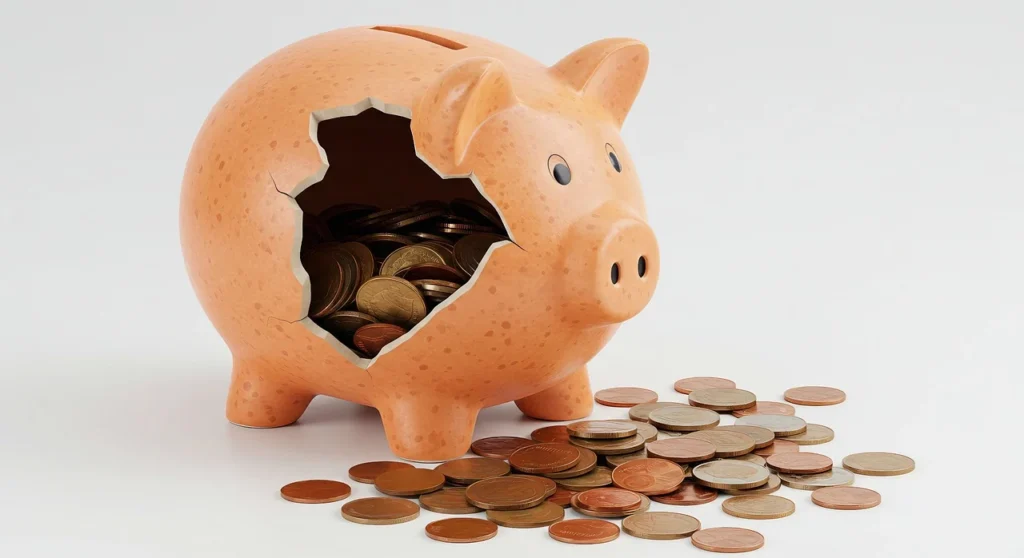
What Is an Emergency Fund?
An emergency fund is a dedicated savings account for unexpected expenses and financial emergencies. This money acts as a financial safety net.
Emergency funds cover job loss, medical bills, car repairs, and home maintenance issues. They prevent reliance on credit cards during crises.
These funds should remain easily accessible but separate from daily spending accounts. Accessibility matters more than high returns for emergency money.
Why Emergency Funds Are Essential
Financial emergencies affect everyone regardless of income level or employment stability. Unexpected expenses can devastate unprepared families quickly.
Emergency funds provide peace of mind and reduce financial stress significantly. This psychological benefit improves decision-making across all life areas.
Without emergency funds, people rely on high-interest credit cards or loans. These debt solutions create long-term financial problems and stress.
Common Financial Emergencies
Job Loss: Unemployment can last weeks or months requiring sustained financial support. Emergency funds bridge income gaps effectively.
Medical Expenses: Health insurance doesn’t cover all medical costs completely. Deductibles, copays, and uncovered treatments require cash payments.
Car Repairs: Vehicle breakdowns happen unexpectedly and require immediate attention. Transportation needs cannot be delayed without significant consequences.
Home Maintenance: Roof leaks, HVAC failures, and plumbing issues demand urgent repairs. Homeowners face expensive emergency repairs regularly.
Family Emergencies: Sudden travel for family crises or funeral expenses arise unexpectedly. These situations require immediate financial resources.
Step 1: Set Your Initial Emergency Fund Goal

Start with a small, achievable goal of $500-$1,000 for your initial emergency fund. This starter fund handles minor emergencies effectively.
Small goals feel less overwhelming and build confidence through early success. Achievement motivation encourages continued progress toward larger targets.
This initial fund prevents new credit card debt during small emergencies. Even modest protection provides significant psychological and financial benefits.
Why Start Small
Large emergency fund targets can feel overwhelming and delay getting started. Procrastination prevents any progress toward financial security.
Small initial goals can be achieved in 1-3 months with focused effort. Quick wins build momentum for larger financial objectives.
Starting immediately with small amounts beats waiting for perfect conditions. Time and consistency matter more than initial contribution size.
Calculating Your Starter Fund Target
Review your recent small emergencies and unexpected expenses from the past year. Common amounts range from $200-$800 for minor issues.
Consider your insurance deductibles for auto and health coverage. Your emergency fund should cover these amounts at minimum.
Factor in your risk tolerance and financial anxiety levels. Higher anxiety individuals benefit from slightly larger starter funds.
Step 2: Choose the Right Account Type
Select high-yield savings accounts for emergency funds to maximize growth while maintaining accessibility. Online banks typically offer superior interest rates.
Money market accounts provide similar benefits with potential check-writing privileges. These accounts maintain FDIC insurance protection up to $250,000.
Avoid checking accounts for emergency funds due to low interest rates. Keep emergency money separate from daily spending accounts.
High-Yield Savings Accounts
Online banks offer interest rates 10-20 times higher than traditional banks. This extra income helps emergency funds grow faster.
FDIC insurance protects deposits up to $250,000 per account per bank. Government backing provides complete security for emergency funds.
Most high-yield accounts have no minimum balance requirements or monthly fees. This flexibility suits emergency fund building perfectly.
Money Market Accounts
Money market accounts often provide slightly higher rates than savings accounts. They may include limited check-writing or debit card access.
These accounts typically require higher minimum balances than savings accounts. Consider your starting fund size when choosing account types.
Some money market accounts offer tiered interest rates rewarding larger balances. Higher balances earn better returns over time.
What to Avoid
Avoid certificates of deposit for emergency funds despite higher interest rates. Early withdrawal penalties defeat the purpose of emergency access.
Don’t use investment accounts for emergency funds due to volatility risk. Stock markets can decline when you need money most.
Skip checking accounts for emergency funds due to low returns. These accounts provide convenience but don’t grow emergency reserves.
Step 3: Automate Your Savings
Set up automatic transfers from checking to emergency fund accounts immediately. Automation removes willpower and memory from the savings equation.
Start with affordable amounts like $25-$50 per week or bi-weekly. Small consistent transfers build substantial funds over time.
Schedule transfers right after payday when money is available. This timing prevents spending money earmarked for emergency savings.
Benefits of Automation
Automatic savings eliminates decision fatigue and procrastination completely. The money transfers without requiring ongoing attention or motivation.
Consistency beats large occasional contributions for building emergency funds. Regular small amounts compound more effectively than sporadic large deposits.
Automation treats emergency fund building like a monthly bill payment. This mental framework prioritizes saving over optional spending.
Setting Up Automatic Transfers
Contact your bank or use online banking to schedule recurring transfers. Most banks offer free automatic transfer services.
Choose transfer amounts that fit comfortably within your monthly budget. Uncomfortable amounts lead to canceling automation prematurely.
Start immediately rather than waiting for perfect timing or amounts. Beginning the habit matters more than the initial transfer size.
Step 4: Find Extra Money to Save
Review your monthly budget to identify potential emergency fund contributions. Small spending cuts can generate significant savings over time.
Cancel unused subscriptions and memberships that drain your budget monthly. These forgotten expenses often total $50-$200 per month.
Reduce dining out and entertainment expenses temporarily while building emergency funds. These cuts are temporary sacrifices for long-term security.
Budget Optimization Strategies
Track all expenses for one month to identify unnecessary spending patterns. Awareness often reveals surprising spending habits and opportunities.
Use the 50/30/20 budgeting rule: 50% needs, 30% wants, 20% savings. Prioritize emergency fund building within your savings allocation.
Consider the envelope budgeting method for better spending control. Physical cash limits prevent overspending in discretionary categories.
Increasing Income Sources
Sell unused items around your home for quick emergency fund contributions. Decluttering generates cash while improving living spaces.
Consider temporary side hustles like food delivery or freelance work. Extra income accelerates emergency fund building significantly.
Use tax refunds, bonuses, or unexpected windfalls for emergency funds. Large lump sums can jump-start your emergency savings goals.
Ask for overtime hours at work if available and needed. Additional work hours provide extra income specifically for emergency savings.
Step 5: Track Your Progress
Monitor your emergency fund growth monthly to maintain motivation and momentum. Visual progress tracking encourages continued contributions.
Use spreadsheets, apps, or simple notebooks to record account balances. Choose tracking methods that you’ll use consistently over time.
Celebrate milestones like reaching $500, $1,000, or monthly expense targets. Recognition reinforces positive saving behaviors effectively.
Progress Tracking Methods
Simple spreadsheets track balances, contributions, and progress toward goals. Visual charts show progress more effectively than numbers alone.
Banking apps often provide automatic savings tracking and goal monitoring. These tools simplify progress tracking without extra effort.
Physical thermometer charts posted visibly provide constant visual motivation. Seeing progress daily encourages continued effort and contributions.
Staying Motivated
Set smaller interim goals within your larger emergency fund target. Achieving $250, $500, and $750 milestones maintains momentum effectively.
Share your goals with supportive family members or friends. Accountability partners encourage consistency and celebrate achievements.
Remember the peace of mind and security that emergency funds provide. Focus on benefits rather than sacrifice during building phases.
Step 6: Gradually Increase Your Target
Once you reach your initial $500-$1,000 goal, expand your target gradually. Aim for one month of essential expenses as your next milestone.
Calculate monthly essential expenses including housing, utilities, food, and minimum debt payments. This amount becomes your expanded target.
Continue building until you reach 3-6 months of essential expenses. Larger funds provide comprehensive protection against major emergencies.
Determining Your Full Emergency Fund Target
Conservative approach: Save 6 months of expenses for maximum security. This amount handles extended job loss or major health issues.
Moderate approach: Target 3-4 months of expenses for balanced protection. This covers most common emergency situations adequately.
Consider your job security, health, and family situation when setting targets. Riskier situations warrant larger emergency fund targets.
Learn more about determining your ideal emergency fund size for your specific situation and needs.
Building Beyond the Basics
Once you reach your target, maintain the fund at that level. Don’t continue building emergency funds beyond 6-8 months of expenses.
Excess emergency savings should be invested for higher returns long-term. Emergency funds prioritize security over growth potential.
Adjust your target as life circumstances change significantly. Job changes, marriage, children, or homeownership affect emergency fund needs.
Common Emergency Fund Mistakes
Starting Too Late
Many people delay starting emergency funds until they have higher incomes. This procrastination leaves families vulnerable to financial disasters.
Start building emergency funds immediately regardless of income level. Even $10 monthly builds meaningful protection over time.
Perfect timing never arrives for most people’s financial situations. Begin with available resources rather than waiting for ideal conditions.
Setting Unrealistic Goals
Overly ambitious initial goals often lead to abandoning emergency fund efforts. Start small and build momentum through early successes.
Emergency fund building is a marathon, not a sprint process. Sustainable approaches produce better long-term results than extreme measures.
Adjust goals based on actual progress and life circumstances. Flexibility prevents discouragement when original timelines prove unrealistic.
Using Emergency Funds for Non-Emergencies
Define true emergencies clearly before accessing emergency fund money. Vacations, sales, and wants don’t qualify as legitimate emergencies.
True emergencies are unexpected, necessary, and urgent financial needs. They cannot be delayed or avoided without serious consequences.
Replace used emergency funds immediately after accessing them for legitimate crises. Maintaining full emergency protection requires prompt replenishment.
Keeping Funds Too Accessible
Emergency funds should be easily accessible but not convenient for impulse spending. Separate accounts prevent accidental or tempting withdrawals.
Avoid keeping large emergency funds in checking accounts used daily. This proximity increases temptation for non-emergency spending.
Consider online banks for emergency funds to create slight access friction. The extra step of transferring money prevents impulse withdrawals.
Advanced Emergency Fund Strategies
Laddering Emergency Funds
Keep 1-2 months of expenses in high-yield savings for immediate access. This portion handles most common emergency situations effectively.
Place additional months in higher-yield accounts with slight access delays. Money market accounts or short-term CDs provide better returns.
This laddering approach maximizes returns while maintaining emergency accessibility. Different access levels suit different emergency timeframes.
Tax Considerations
Emergency fund interest is taxable as ordinary income annually. High-yield accounts generate higher tax obligations than low-yield alternatives.
Consider keeping emergency funds in tax-advantaged accounts like Roth IRAs. Contributions can be withdrawn penalty-free before age 59½.
However, investment account volatility conflicts with emergency fund stability needs. Traditional savings accounts often provide better emergency fund security.
Insurance Integration
Adequate insurance reduces emergency fund requirements by covering specific risks. Health, auto, and homeowners insurance protect against major expenses.
Higher insurance deductibles lower monthly premiums but increase emergency fund needs. Balance premium savings against emergency fund requirements.
Disability insurance protects income during extended inability to work. This coverage reduces emergency fund requirements for income replacement.
Building Emergency Funds on Low Income
Micro-Saving Strategies
Round up purchases to the nearest dollar and save the difference. These small amounts accumulate surprisingly quickly over time.
Save loose change in jars or piggy banks for emergency funds. Physical saving makes progress visible and builds positive habits.
Use cash-back apps and credit card rewards for emergency savings. Redirect rewards and rebates to emergency fund accounts automatically.
Government and Community Resources
Research local assistance programs that provide emergency financial help. These resources reduce the emergency fund burden for qualifying individuals.
Food banks and utility assistance programs free up money for emergency savings. Community resources extend limited income further effectively.
Tax preparation services help maximize refunds for emergency fund contributions. Professional preparation often increases refund amounts significantly.
Gradual Income Improvement
Invest in skills training or education that increases earning potential. Higher incomes make emergency fund building significantly easier.
Network within your industry for better job opportunities and advancement. Career development provides long-term financial security improvements.
Consider additional income sources through part-time work or side businesses. Extra income streams accelerate emergency fund building substantially.
Emergency Fund Maintenance

Regular Review and Adjustment
Review emergency fund adequacy annually or after major life changes. Marriage, children, job changes, or homeownership affect fund requirements.
Inflation reduces purchasing power over time requiring fund adjustments. Annual increases maintain emergency fund effectiveness against rising costs.
Monitor account interest rates and switch if better options become available. Rate shopping maximizes emergency fund growth over time.
Replenishing After Use
Immediately begin rebuilding emergency funds after legitimate withdrawals. Prompt replenishment maintains continuous emergency protection coverage.
Temporarily reduce other financial goals to prioritize emergency fund restoration. Emergency protection takes precedence over investment or debt payoff goals.
Consider increasing monthly contributions temporarily to accelerate fund rebuilding. Faster restoration reduces vulnerability periods after emergency fund use.
Avoiding Lifestyle Inflation
Resist the temptation to increase spending as emergency funds grow. Larger funds should provide security, not spending justification.
Maintain the same spending discipline that built the emergency fund initially. Good financial habits require consistent practice over time.
Focus on the peace of mind that emergency funds provide. This psychological benefit often exceeds the monetary value significantly.
Professional Guidance and Resources
When to Seek Help
Complex financial situations may benefit from professional financial planning guidance. Fee-only advisors provide objective emergency fund advice.
Major life changes like divorce or inheritance require specialized planning. Professional guidance helps navigate complex emergency fund decisions.
Small emergency fund questions rarely require professional help. Basic emergency fund building is straightforward for most people.
Educational Resources
Investopedia provides comprehensive emergency fund education and guidance. Their articles cover basic through advanced emergency fund strategies.
Personal finance books and podcasts offer additional emergency fund insights. Multiple perspectives help develop comprehensive emergency fund understanding.
Bank websites often provide emergency fund calculators and tools. These resources help determine appropriate fund sizes and saving timelines.
Community Support
Online personal finance communities provide motivation and accountability support. Sharing progress with others encourages continued emergency fund building.
Local financial literacy classes teach emergency fund basics effectively. Group learning environments provide support and encouragement for participants.
Credit union financial counseling services often provide free emergency fund guidance. These resources help members build financial stability systematically.
Conclusion
Starting an emergency fund requires clear goals, appropriate accounts, and consistent contributions. These foundations create financial security and peace of mind.
Begin with small, achievable targets of $500-$1,000 before building larger reserves. Early success builds momentum for continued financial progress.
Automation eliminates willpower from emergency fund building while ensuring consistent progress. Set up automatic transfers immediately after account opening.
Choose high-yield savings accounts for optimal emergency fund growth and accessibility. Online banks typically provide superior interest rates and terms.
Track progress regularly and celebrate milestones to maintain motivation throughout the building process. Visual progress tracking encourages continued contributions.
Remember that emergency funds provide security that enables other financial goals. This foundation supports investment, homeownership, and retirement planning effectively.
Frequently Asked Questions
How much should I save each month for my emergency fund?
Save whatever amount fits comfortably in your budget consistently. Even $25 monthly builds meaningful emergency protection over time.
Aim for 10-20% of your monthly income toward emergency funds initially. Adjust this percentage based on your specific financial situation.
Consistency matters more than the specific monthly amount saved. Regular small contributions outperform sporadic large deposits significantly.
Should I build an emergency fund or pay off debt first?
Build a small starter emergency fund of $500-$1,000 first. This prevents new debt during minor emergencies while paying off existing debt.
Focus on high-interest debt elimination after building your starter fund. Credit card debt typically exceeds emergency fund returns significantly.
Return to building your full emergency fund after eliminating high-interest debt. This balanced approach provides security while minimizing interest costs.
Where should I keep my emergency fund money?
High-yield savings accounts offer the best combination of accessibility and returns. Online banks typically provide superior interest rates consistently.
Money market accounts provide similar benefits with potential additional features. Choose based on your specific accessibility and return preferences.
Avoid investment accounts for emergency funds due to volatility risks. Emergency money should remain stable and immediately accessible always.
How do I avoid spending my emergency fund on non-emergencies?
Define true emergencies clearly before building your fund completely. Write down your emergency criteria and refer to them before withdrawals.
Keep emergency funds in separate accounts from daily spending money. This physical separation reduces temptation for non-emergency spending.
Create a 24-48 hour waiting period before emergency fund withdrawals. This cooling-off period prevents impulse spending from the fund.
What counts as a legitimate emergency expense?
True emergencies are unexpected, necessary, and urgent financial needs. They cannot be delayed without serious negative consequences.
Examples include job loss, medical expenses, major car repairs, and home maintenance emergencies. These situations require immediate financial response.
Vacations, sales, and discretionary purchases don’t qualify as emergencies. Save separately for these planned or optional expenses instead.
Should I invest my emergency fund for higher returns?
Keep emergency funds in stable, accessible accounts rather than investments. Volatility conflicts with emergency fund accessibility and security needs.
Investment accounts can lose value when you need emergency money most. Economic downturns often coincide with personal financial emergencies.
Focus on accessibility and stability over returns for emergency funds. Higher returns aren’t worth the risk of capital loss during crises.
Leave a Reply